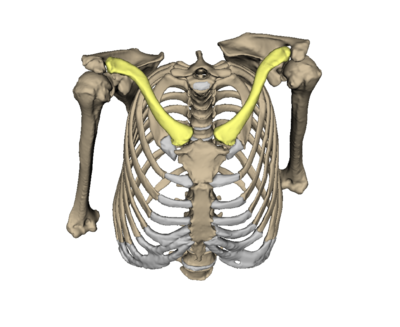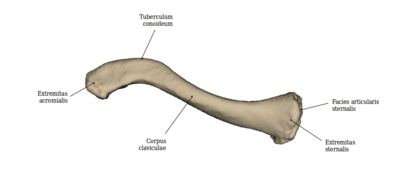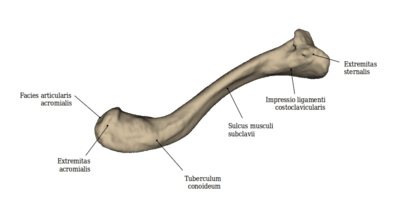Schlüsselbein/en: Unterschied zwischen den Versionen
(Die Seite wurde neu angelegt: „The clavicle is a tubular bone bent into an "S" shape. From cranial view the medial end shows a ventral convexity. This convexity takes up about 2/3 of the len…“) |
(Die Seite wurde neu angelegt: „The thickened sternal end of the clavicle is called <i>Extremitas sternalis</i>. This name is due to its location adjacent to the sternum. On this side of the…“) |
||
| Zeile 14: | Zeile 14: | ||
The clavicle is a tubular bone bent into an "S" shape. From cranial view the medial end shows a ventral convexity. This convexity takes up about 2/3 of the length of the entire bone. The lateral side, in contrast, shows a ventral concavity. In an adult, the clavicle is 12-15 cm long and can be palpated over its entire length. | The clavicle is a tubular bone bent into an "S" shape. From cranial view the medial end shows a ventral convexity. This convexity takes up about 2/3 of the length of the entire bone. The lateral side, in contrast, shows a ventral concavity. In an adult, the clavicle is 12-15 cm long and can be palpated over its entire length. | ||
| − | + | The thickened sternal end of the clavicle is called <i>Extremitas sternalis</i>. This name is due to its location adjacent to the sternum. On this side of the clavicle a saddle-shaped, three-sided articular surface is formed, which is covered with the <i>Facies articularis sternalis</i>. The lateral side of the clavicle is called <i>Extremitas acromialis</i> due to its connection to the acromion of the scapula. There is a rather plate, vertically oriented surface. This is almost oval and covered with the <i>Facies articularis acrommialis</i>. The area of the collarbone between the two ends is called <i>Corpus claviculae</i>. | |
Betrachtet man die Clavicula von kaudal, so zeigen sich weitere Strukturen. Zur akromialen Seite ist eine knöcherne Erhebung ausgeprägt, die <i>Tuberculum conoideum</i>. Dies ist auch aus kranialer Sicht erkennbar. Lateral davon befindet sich aus kaudal die <i>Linea trapezoides</i>. Der Corpus claviculae ist aus kaudal durch eine längliche Vertiefung, die Sulcus musculi subclavia heißt, geprägt. Aus kaudal zeigt sich an der Extremitas sternalis eine Vertiefung, die <i>Impressio ligamenti costoclavicularis</i>. | Betrachtet man die Clavicula von kaudal, so zeigen sich weitere Strukturen. Zur akromialen Seite ist eine knöcherne Erhebung ausgeprägt, die <i>Tuberculum conoideum</i>. Dies ist auch aus kranialer Sicht erkennbar. Lateral davon befindet sich aus kaudal die <i>Linea trapezoides</i>. Der Corpus claviculae ist aus kaudal durch eine längliche Vertiefung, die Sulcus musculi subclavia heißt, geprägt. Aus kaudal zeigt sich an der Extremitas sternalis eine Vertiefung, die <i>Impressio ligamenti costoclavicularis</i>. | ||
Version vom 6. Februar 2020, 08:36 Uhr
Inhaltsverzeichnis
Overview
The clavicle (lat. Clavicula) is a pairwise tubular bone. It has an "s"-shaped bend and is located in the shoulder girdle. It is the only direct connection between the free upper extremity and the trunk.
Anatomy
The clavicle is located in the shoulder girdle and thus at the front of the torso. Medially it is limited by the Sternum and laterally by the Arcomion of the shoulder blade. The connection to the sternum is the only direct link between the free upper extremity and the trunk.
The clavicle is a tubular bone bent into an "S" shape. From cranial view the medial end shows a ventral convexity. This convexity takes up about 2/3 of the length of the entire bone. The lateral side, in contrast, shows a ventral concavity. In an adult, the clavicle is 12-15 cm long and can be palpated over its entire length.
The thickened sternal end of the clavicle is called Extremitas sternalis. This name is due to its location adjacent to the sternum. On this side of the clavicle a saddle-shaped, three-sided articular surface is formed, which is covered with the Facies articularis sternalis. The lateral side of the clavicle is called Extremitas acromialis due to its connection to the acromion of the scapula. There is a rather plate, vertically oriented surface. This is almost oval and covered with the Facies articularis acrommialis. The area of the collarbone between the two ends is called Corpus claviculae.
Betrachtet man die Clavicula von kaudal, so zeigen sich weitere Strukturen. Zur akromialen Seite ist eine knöcherne Erhebung ausgeprägt, die Tuberculum conoideum. Dies ist auch aus kranialer Sicht erkennbar. Lateral davon befindet sich aus kaudal die Linea trapezoides. Der Corpus claviculae ist aus kaudal durch eine längliche Vertiefung, die Sulcus musculi subclavia heißt, geprägt. Aus kaudal zeigt sich an der Extremitas sternalis eine Vertiefung, die Impressio ligamenti costoclavicularis.
Gelenke
Die Verbindung des Schlüsselbeins zum Sternum erfolgt über das Sternoklavikulargelenk. Dieses verbindet die folgenden knöchernen Strukturen miteinander: Extremitas sternalis und Manubrium sterni.
Die Clavicula und die Scapula korrelieren über das Akromioklavikulargelenk. Dieses verbindet die Extremitas acromialis und das Acromion des Schulterblattes.
Entwicklung
Die Clavicula wird in der embrionalen Entwicklung aus einer bindegewebigen Grundlage entwickelt. Somit stellt sie den einzigen Knochen in einer Extremität dar, der nicht durch einen Knorpel vorgeformt wird. Das Schlüsslbein ist allerdings einer der knochen, die sich am frühsten entwickeln. So verknöchert ihre Diaphyse schon in der Embryonalwoche sechs bis sieben. Bei den Epyphysen ist erst im Alter von 16 bis 18 Jahren ein verknöcherter Kern nachzuweisen. Die hier befindelichen Epiphysenfugen verschließen sich erst mit 20 bis 25 Lebensjahren. Sie sind damit die Fugen, die sich im menschlichen Körper als letzte verschließen.
Erkrankungen
Zum freien Explorieren der Schlüsselbeine starten Sie den WebSegmenter.
<segmenter border="1">https://dornheim.cloud/index.php/apps/segmenter/embedding/view?identifier=b7GTgSO6dYaQ</segmenter>
weiterführende Links


